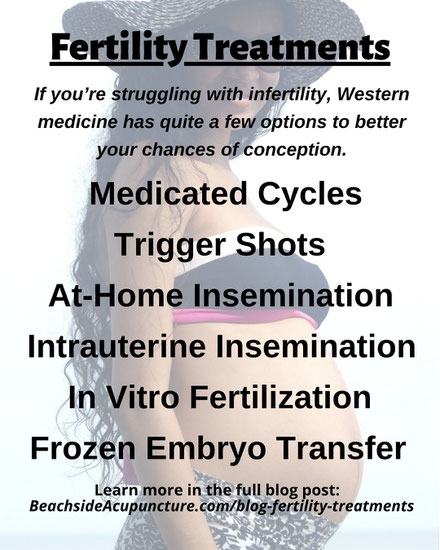
This post contains affiliate links, meaning Beachside Community Acupuncture PLLC may receive a small commission for purchases made through certain links at no additional cost to you. (In other words, you support us in a small way when you buy the products that we highly recommend and would use ourselves!) Click here to view our full disclosure policy.
We see quite a few fertility patients at our clinic, ranging from those wanting to regulate their cycles before even thinking about having a baby to those deep in assisted reproductive technology (ART). Some of our patients have shared that they were overwhelmed when listening to their doctor discuss the various fertility treatment options, so we're writing this blog post to clear up some of the confusion!
Trying to Conceive Naturally
When just starting out, it's recommended to spend one year trying to conceive (TTC) if you are less than 35 years old and six months if you are older than 35. During this time, you'd ideally be having sex within your fertile window each cycle, and you may need to track your cycle to get the timing correct. Devices like Inito, Oura Ring, and Kegg can make tracking easy, but if having to time intercourse close to ovulation is too stressful, simply having sex more often in the seven to ten days in the middle of the cycle may be a good place to begin.
Fertility testing for both partners is recommended after the six to twelve-month period, but you may opt to test earlier if you have known issues, such as anovulation with polycystic ovary syndrome (PCOS) or scar tissue from previous procedures. After testing - or maybe even before depending on your situation - your doctor may recommend fertility treatments to help you conceive more quickly.
Medicated Cycles
All Western fertility treatments manipulate the body in some way, most often to assist it in what it should already being doing and/or intensify its natural processes. The most basic treatment is to take at least one medication:
- Drugs to stimulate the ovaries to produce more follicles can be taken for a few days during the follicular phase. (Clomid and Letrozole are two common options.)
- An injection called a "trigger shot" can be given to force ovulation, making it easier to pinpoint when it will occur.
- Progesterone taken during the luteal phase can supplement the progesterone made by the body.
At-Home Insemination or Intrauterine Insemination
Insemination takes sex out of the equation as it delivers a sperm sample directly into either the vagina or uterus:
- In at-home insemination, the sperm sample is injected into the vagina near the cervix close to ovulation, usually after a luteinizing hormone (LH) surge is seen on a predictor strip or a tracking device. Home insemination is done with a kit, and while it's a good idea to discuss the best strategy with a doctor, the doctor does not have to oversee the insemination itself.
- Intrauterine insemination (IUI) is performed by a doctor and usually involves some medication and monitoring before the washed sperm sample is injected into the uterus. IUI is a step above home insemination in that it bypasses the cervix to put the washed sperm closer to where it needs to be to fertilize an egg.
Women TTC without a partner, same-sex couples, and women whose partners are unable to have sex will usually start with insemination, but this type of treatment can also be very helpful for other couples as it manipulates reproduction a bit more. Doctors will usually allow three to six cycles of IUI before pushing to move to a more advanced procedure.
In Vitro Fertilization
In vitro fertilization (IVF) requires the most time, money, and effort but also has the highest success rates because it micromanages every part of reproduction. While there are IVF options that rely on fewer medications and less manipulation, the standard IVF protocol follows these steps:
- Pre-IVF cycle regulation with birth control or Lupron to start with a clean slate.
- Retrieval of eggs after taking medications to stimulate follicle growth while suppressing ovulation. The eggs are then combined with sperm and the resulting embryos are left to mature. Sometimes intracytoplasmic sperm injection (ICSI) is required to fertilize the eggs with individual sperm cells.
- Transfer of embryo(s)* into the uterus for implantation after taking medications to enhance uterine lining. A "fresh" IVF would have a transfer quickly after retrieval, but it's become more common for doctors to recommend freezing the embryos for a later transfer date. Opting for a frozen embryo transfer (FET) allows time for preimplantation genetic testing (PGT) to rate the quality of the embryos before choosing which to use.
- Blood work to confirm pregnancy (beta hCG check) about 9 to 10 days after transfer. If the transfer was successful, progesterone injections are continued for at least another few weeks. (Some doctors base progesterone supplementation on blood work, but others have patients continue it until weeks ten to thirteen regardless.)
This is a very simple breakdown of the IVF process! In reality it involves numerous doctor visits to check hormone levels and follicle or uterine lining growth. Multiple medications will be given - they can be in the form of pills, patches, vaginal suppositories, or injections - and other supplements or drugs may also be required as part of the protocol.
*If you've watched Friends or old reality TV, you may be worried about having too many embryos implant. Doctors nowadays are very careful about preventing Octomom situations and will often only allow one embryo to be transferred at a time. Every once in a while we'll have a patient whose doctor allows two, but even that is less common as there's a slight risk of both embryos splitting to produce quadruplets.

No matter which route you choose on your path to building your family, healthy diet and lifestyle choices will always have a huge impact! Stress management, nutrition, gentle exercise, adequate sleep... All of the things that nourish the body as a whole will help it feel safe enough to welcome the added stresses of carrying and delivering a baby. Take care of yourself with the intention of taking care of your unborn child, and consider acupuncture if you need extra support during your fertility journey.

Kathleen Ketola is a Licensed Acupuncturist and the owner of Beachside Community Acupuncture. She loves providing affordable acupuncture to the residents of McKinney, Texas, and surrounding cities like Prosper, Frisco, and Melissa, but she also enjoys educating the general public on how acupuncture and Traditional Chinese Medicine (TCM) can treat everything from pain to infertility to stress and beyond. Click "Book Now" at the top of this page to book an appointment or feel free to contact her at (214) 417-2260.









